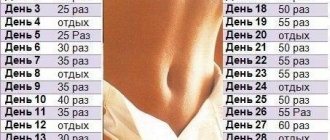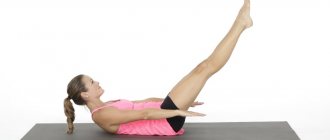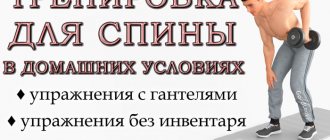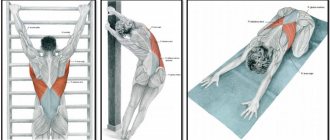Home / Programs / Quadratus lumborum exercises
Back
- Workouts:
In the gym and at home - Complex:
Universal - Muscle group:
Back - Goal:
Endurance - Difficulty:
medium - Equipment:
Dumbbells and Barbell/Absent
☝ Details on WhatsApp
Before starting your back workout, do warm-up exercises and warm up all the muscles in your body.
Let's start with the basic basic exercises for the quadratus lumborum muscle - exercises with axial load on the spine.
If you have hernias or back protrusions, remove these exercises from your workout. It can be done carefully with minimal weight in static dynamics, in the absence of pain in the spine.
Anatomy
First, it’s worth considering the anatomy of the quadratus dorsi muscle. It is located between the iliac crest bone of the spine and the 12th rib. It is represented by paired, flat muscles that reach the back wall of the abdomen. Includes the quadratus posterior and anterior muscles.
The determining function is the movement of the ilium of the back. Also, local muscles pull the twelfth rib down. The quadratus dorsi muscle is involved in side-to-side movements of the lower back. Its bilateral contractions cause the spinal column to be pulled back in the lumbar region.
What causes muscle weakness?
Its weakening can contribute to the formation of a “flat back” or the appearance of stoop. Tension in the back of the hip joint causes hip extension. In its normal state, the iliopsoas provides support and counteracts strong tension.
Read also…. Paresis of the limbs
If stooping occurs, then with prolonged stretching, the ligaments in the front of the hip joint feel severe stress. This is fraught with impaired stability, muscle imbalance due to strong tissue compensation, and the appearance of osteochondrosis.
Symptoms
How to understand that the cause of lower back pain is damage to the quadratus dorsi muscle? The symptoms here are:
- Periodic numbness of the lower extremities, tingling sensation in the feet.
- Regular pain in the lower back, which cannot be eliminated even by giving up physical activity and taking quality, long rest.
- Gradually increasing discomfort with the slightest activity.
- Increased discomfort in the lower back when going to bed.
- Numbness of the tissues in the perineal area.
- Feeling of stiffness in the lower spine for half an hour after waking up.
- Spread of pain from the lower back to the buttocks area.
If the quadratus dorsi muscle constantly hurts, one, several or a combination of the above symptoms are noted, then you should think about visiting a qualified doctor for a diagnosis.
muscle syndrome
It is a secondary symptom and makes itself felt, as a rule, after injuries and sprains.
In addition, it can be caused by the following problems:
- dystrophic lesions of tendons;
- arthritis;
- vertebral syndrome;
- tenosynovitis;
- various inflammatory disorders;
- cancerous tumor;
- impaired blood supply;
- aseptic necrosis.
As medical statistics show, the diseases of the iliac spine listed above are diagnosed mainly in young people. The detection rate is about 2.5 percent. But the pathologies are very serious and require immediate treatment.
Causes
There are a wide range of prerequisites for the development of quadratus dorsi syndrome. The cause of its occurrence is quite often a sedentary lifestyle, in particular, prolonged sitting every day. The lack of moderate physical activity on the muscles in the lumbar region leads to stagnant processes. The muscles are poorly supplied with oxygen and nutrients. Local blood flow suffers. Atrophic phenomena cause voluntary contractions of tissues. Muscle fatigue develops. The lack of healthy loads on the muscles of the lower back provokes pain and leads to tissue stiffness.
Another common cause is poor posture. Holding your back in an unnatural position creates additional stress on the muscles. The result is the development of discomfort and quite noticeable pain. People who, for one reason or another, have to sit at a computer all day suffer from this especially.
In some cases, the syndrome develops in the presence of congenital pathology of the musculoskeletal system. We are talking about different lengths of the lower limbs. There is an unequal load on individual parts of the quadratus muscle. Usually pain makes itself felt on the side of the lower back where the longer leg is located. The other part of the quadratus muscle gradually shortens due to minor physical activity.
Traumatic effects on the lower back can also lead to the development of the syndrome. This could be impacts or tissue damage during sports. Lifting excessively heavy loads has a negative impact on the condition of the muscles in this area.
The quadratus muscle needs regular training. After all, it is these muscles that are responsible for maintaining the spine in its natural position. Weakening of the local muscle corset does not allow one to cope with serious physical activity. Therefore, it is not surprising that without periodic training, the muscle begins to quickly get tired, overload, and the pain begins to radiate to the lower back.
Main complex
The iliopsoas muscle, for which exercises are divided into three main groups, may need strengthening, stretching or relaxing. The return of PPM functions lost during life may be associated with each of the described techniques
A set of yoga exercises is used to stretch and lengthen the iliopsoas muscle.
Physical therapy based on fixing a static load allows you to simultaneously stretch and strengthen the target muscle group.
The following complex of treatment and preventive measures has become widespread:
- Exercise "Rider". Performed by analogy with classic lunges on one leg without stepping forward. Starting position: the left leg is placed far forward in front of you, the right leg is laid back as far as possible. And the indicated position is lowered down until the knee of the right leg touches the floor. In this case, at the lowest point, the thigh of the front left leg should be parallel to the floor. As training progresses, the heel of the front limb can be moved closer to the buttocks. The student’s body should be positioned perpendicular to the floor (a slight backward shift from the vertical plane is allowed). It is important to ensure that the physiological deflection in the lower back is maintained. After a delay in the indicated position for 5-15 seconds. you should change the position of your legs. The right limb moves forward, and the left limb moves back.
- Stretching from a sitting position on the floor. Sit on a flat surface, legs in front of you, knees bent. It is necessary to connect the lower parts of both feet, while the knees diverge to the sides and touch the floor. From this position, you should bend your body forward until your chest touches the floor or as deeply as possible. If you have sufficient flexibility, it is possible to bend forward with your legs straight, extended forward and together. In this case, you should clasp your feet with your hands and lower yourself as deeply as possible, pulling your body down with your hands.
Exercise to stretch the iliopsoas muscle
One of the common ways to strengthen the iliopsoas muscle is to perform exercises on the horizontal bar. Hanging leg pull-ups can be performed both in the style of static and dynamic loads.
Exercises on the horizontal bar:
| Press leg raises 3-4*15-20 reps | To perform the exercise, you must be positioned correctly on the horizontal bar. Your hands should tightly grasp the crossbar “in the lock”. This means that your thumbs should grip the horizontal bar from below, not from above. In this case, your hands should be shoulder-width apart. This will prevent swaying. Raising the bent legs is carried out until the knees touch the chest. Lowering the lower limbs to the starting position should be done smoothly. |
| Hanging leg raises with delay at the top | The exercise is completely similar to that discussed above, but is performed in the style of a static load. It is necessary to raise your legs up until they touch your chest and fix them in this position for as long as possible. |
| Horizontal corner | The exercise is performed from a supine position. Hands at your sides, slightly away from the body and turned palms down. Shoulders and head are pressed to the floor. From the starting position, the straight legs are raised up to the vertical. It is important to ensure that the abdominal muscles and abdominal muscles receive continuous exercise. Excessive abduction of the legs into the plane of the abdomen is not allowed. |
The iliopsoas muscle, for which relaxation exercises are available to people of any level of physical fitness, is prone to spasms. A sedentary lifestyle can lead to misalignment of muscle fibers or excessive tension in the abdominal muscles.
To eliminate spasms, a set of exercises is used aimed at gradual relaxation and tension of the abdominal muscles:
- Relaxation stage . Performs within 1-2 minutes. It is necessary to lie down on a bed or sofa so that the body is securely located on the supporting surface. The legs should hang over the edge. In this case, the position of the lower back should be fixed in an anatomically correct position. To do this, you need to place a soft cushion under it. From the described position, tense your muscles and raise your straight legs until they are parallel to the floor. Then start bending them without stopping. At the end point, the thighs should be perpendicular to the floor, and the lower legs should be suspended (the feet do not touch the surface of the bed or sofa).
- Voltage stage. Performs within 5-10 seconds. From the final position from the relaxation stage, you need to straighten your legs brought together to a line parallel to the floor. Fix this position for the specified time and return to the relaxation stage.
Diagnostics
How can you tell if your quadratus dorsi muscle is damaged? Diagnosis involves performing a series of examinations. There is a whole set of diseases whose symptoms are similar to quadratus muscle syndrome. Among these are:
- osteochondrosis;
- scoliosis;
- arthrosis;
- uterine fibroids;
- bladder infections;
- inflammation of the pelvic organs.
Therefore, the first priority is to conduct ultrasound and radiography. The results of such tests make it possible to exclude the development of the above diseases. Based on the results of the diagnosis, doctors have the opportunity to find out whether it is possible to talk about the development of quadratus muscle syndrome.
The presence of the disease can also be confirmed by palpation of the area in which discomfort occurs. Palpation of the quadratus muscle will cause a significant increase in pain. Especially if there is pressure on points in the area of the twelfth ribs.
Stretching the iliopsoas muscle[edit | edit code]
Characteristics
:
Iliopsoas stretch
- Iliopsoas muscle stretch - static exercise
- Isolation of one joint
- Closed kinetic chain
- Overcoming your own body weight
- For intermediate and advanced levels
Tightness of the muscles that flex the leg at the hip joint, especially the iliopsoas muscle, causes excessive extension of the lumbar spine when performing exercises in a standing position. This problem is further exacerbated if the stabilizing abdominal muscles are weakened. The proposed exercise helps well in such situations. It must be performed slowly, paying special attention to the execution technique.
Drug treatment
Discomfort in the presence of quadratus muscle syndrome can be eliminated by taking medications that belong to the group of muscle relaxants. Such medications make it possible not only to relieve local pain, but also to relax tissues that are subject to intense voluntary contraction.
Effective anesthetics can be used to relieve discomfort. Such drugs are injected into the muscles through injections. A good addition to therapy are steroid drugs that help eliminate inflammatory processes in tissues.
Pain pattern and trigger zones
Pain may spread to adjacent segments. Trigger zones of MMP can also cause referred pain along the lateral surface of the abdomen.
The following are factors that can activate or reactivate lumbar multifidus trigger zones:
- Car accident (rapid deceleration).
- The presence of trigger points in adjacent muscle groups that are responsible for the movements of the spine (for example, oblique abdominal muscles, quadratus lumborum, paravertebral muscles of the lumbar region, etc.).
- Joint dysfunction of the spine (facet syndrome).
- Changes in the configuration of lumbar lordosis, thoracic kyphosis or the presence of scoliosis.
Friends, Georgy Temichev’s seminar “All about pain” will take place very soon. Find out more...
Quadratus dorsi muscle: exercises
The following exercises allow you to resist the development of the syndrome:
- Stretch up. The body should take a vertical position. The arms are extended as far as possible above the head. Each of them alternately performs movements as if they need to get an apple that hangs on a high branch. At the same time, the right knee bends and the thigh tightens if the left arm reaches up, and vice versa. Each hand performs 10 such “stretches”.
- Side stretch. Kneel down with your hands on the floor. The knees should be closed. You need to tilt your hips to the side as much as possible without feeling discomfort. If you tilt to the left, you should turn your head to the right and look over your shoulder. Then return to the starting position and tilt in the other direction.
- Belly twist. You need to lie on your side. The chest unfolds and presses toward the floor. The arms are extended above the head. A series of deep inhalations and exhalations is performed. Then the body turns over to the other side, the exercise is repeated.
Seated Lateral Stretch
- get down on all fours;
- place your hands exactly under your shoulders;
- The knees and inner thighs should touch and be aligned under the pelvic bone;
- move your hips to the left side, rolling onto the outside of your left leg (your right leg should be on your left);
- look over your right shoulder;
- inhale as you stretch your left lower back and left hip;
- exhale to return to the center position;
- repeat on the other side.
Exposure to heat and cold
Applying ice packs to the lower back is considered a fairly effective method of eliminating muscle pain. The method makes it possible to resist all kinds of tissue inflammation.
What can be said about applying hot compresses to the lower back? Exposure to heat causes saturation of local tissues with blood. The muscles are better fed with nutrients, and metabolic processes are activated. This way the pain gradually goes away. Considerable benefits come from periodic hot baths.
Pelvic floor muscle training
Kegel exercises
Slow Compressions:
- Tighten your muscles as you did to stop urination.
- Slowly count to three.
- Relax.
- It will be a little more difficult if, holding the muscles, hold them in this position for 5-20 seconds, then gradually relax.
“Elevator” - we begin a smooth ascent on the “elevator” - squeeze the muscles a little (1st floor), hold for 3-5 seconds, continue the rise - squeeze a little harder (2nd floor), hold, etc. to your limit - 4-7 “floors”. We go down in the same stages, pausing for a couple of seconds on each floor.
Abbreviations:
- Tighten and relax your muscles as quickly as possible.
Ejections:
- Push down moderately, as if you were in a chair.
Start your training with ten slow compressions, ten contractions and ten push-ups five times a day.
After a week, add five exercises to each, continuing to perform them five times a day.
Add five to each exercise every other week until there are thirty. Then continue to do at least five sets a day to maintain tone. You should do 150 Kegel exercises every day.
Based on materials from applied-kinesiology.narod.ru
Whole spine Gluteal warm-up Hip











